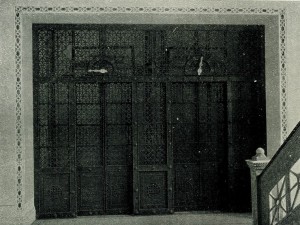Without elevators, buildings in the Loop would be no more than five, or possibly a heart attack inducing six stories tall. This began changing in the 1860s, according to History of the Development of Building Construction in Chicago. Passenger elevators surprised building owners by not only allowing more stories to be added to buildings, but by increasing rents dramatically. In an elevator building, the highest floors, practically worthless in a staircase-only building, became even more valuable than the lower floors.
Perry Duis, writing in the Summer 1987 issue of Chicago History,noted that early commercial elevators ran by steam or water power. The water-powered elevators required pumps, rooftop and basement tanks. By the mid-1890s newly installed elevators were electric. As Jason Goodwin explains in Otis: Giving Rise to the Modern City, all of these technologies were controlled by an “elevator trust" consisting of the Otis Company of New York and Hale of Chicago.
Initially each building had one slow elevator. As architects became more comfortable with the technology, they specified multiple elevators and built even taller buildings. The first floor of buildings also changed. Gone was the grand staircase found in buildings such as the Chicago Cultural Center. Instead, grand lobbies provided a place to wait for the elevators. Many modern office buildings such as the Daley Center have nothing on the first floor except an elevator lobby.
Many of the early elevator companies such as Otis Elevator initially rose to fame, not only by inventing superior elevators, but by inventing safety devices. Nevertheless elevators were quite deadly for a number of years. From the 1870s through the 1950s, the Coroners Reports, the Department of Health Annual Reports and the Chicago Tribune regularly reported passenger and operator deaths in elevators.
Initially many of these deaths were from falling cars. By the 1890s elevators were being fitted with as many as five anti-falling devices. Deaths continued because few buildings underwent the expense of updating their elevators and elevator operators were often careless boys who ignored precautions. People also continued to fall down elevator shafts and get crushed by moving elevators.
These deaths were prevented in later years by requirements for solid inner doors and interlocking devices which prevented opening doors when an elevator was not present and kept elevators from moving if a door was open.
Automatic elevators began to be installed in new commercial buildings in the 1940s. A 1952 Tribune article mentions that automatic elevators had been installed in residential buildings since the 1920s. Although some felt that pilotless elevators were dangerous, new buildings were built with modern automatic elevators and they were retrofitted into older buildings.
By the 1960s elevator operators were less common and fatalities in passenger elevators had become rare. Elevators were taken to new heights with the completion of the John Hancock Building (1968) and Willis Tower (1973.)
Currently the few elevator operators still around just push buttons rather than operating a throttle. However you can still get an old-fashioned ride in the Fine Arts Building.



Add a comment to: Elevators: Technology That Changed Chicago